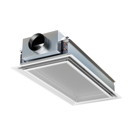Swegon Parasol offers flexible approach

Swegon's Parasol is to all intents and purposes an active chilled beam, but in modular format with four way distribution. This means that not only does it have all of the features and energy benefits of a chilled beam, but with all the flexibility of fan coils.
Adjustability of both air volume and direction on all four sides gives Parasol the flexibility that has been the only drawback of chilled beams in the past. With no fan, Parasol runs silently and consumes no fan power.
Running at higher chilled water temperatures, the chiller providing chilled water to Parasol runs more efficiently, and can also be designed to provide free cooling during a large proportion of the year. With a dry coil, there is no need for a filter in the unit, so maintenance is reduced. And with no moving parts there will be nothing to wear out or break down.
A new model in Swegon’s award winning Parasol range has been launched. Parasol Zenith adds another dimension to the already impressive flexibility of the existing Parasol range, offering greater scope for connection positions, additional unit sizes and a much wider working range and higher capacity.
Flexibility is not limited to initial set up as the unit can be site adjusted, with no special tooling or training required, should the requirements of the building change. With no moving parts meaning an almost unlimited lifespan, there could be many such changes.








